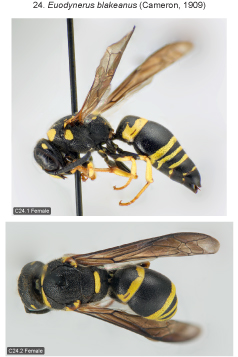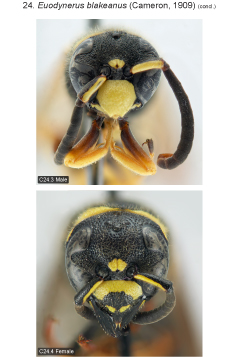
| Home | Table of contents | Keys | Species list | Glossary | Image data | PDF | Cite this article | Feedback | Updates |
Identification Atlas of the Vespidae (Hymenoptera, Aculeata) of the northeastern Nearctic region
CJAI 05, February 19, 2008
doi: 10.3752/cjai.2008.05
Matthias Buck, Stephen A. Marshall, and David K.B. Cheung
Department of Environmental Biology, University of Guelph, Guelph, Ontario, Canada N1G 2W1
Next species | Previous species | Key
24. Euodynerus blakeanus (Cameron, 1909), sp. restit.
Figs B5.2, 18, 52; C24.1–4.

|

|
Taxonomic note. Euodynerus blakeanus was previously considered a subspecies of E. foraminatus even though it is structurally very similar to E. leucomelas. Like several other presumed subspecies of E. foraminatus (e.g., E. apopkensis (Robertson), E. parvirudis (Bohart)) it represents a good species and is well-differentiated morphologically from E. foraminatus. Previously, E. blakeanus was only recorded from Central Texas (Cameron 1909). During this study we identified additional material from six additional states (see below), indicating that the species is widely distributed in the eastern U.S. Its (insufficiently) known range appears to overlap entirely with the more widespread E. foraminatus (we have examined typical E. foraminatus from the type locality of E. blakeanus: Lee Co., Texas; BMNH and USNM). See also taxonomic note under E. leucomelas.
Species recognition. The species differs from both E. foraminatus and the yellow colour form of E. leucomelas by the dull (vs. shining) propodeal concavity and posterior surface of the metanotum, and the yellow apical spots of the female clypeus (absent in other species). It differs furthermore from E. foraminatus by the simple (not thickened) apical margin of tergum 2 and the shallower and finer punctation of preapical areas of terga 2–5.
Variation. Fore wing length ca. 6.5–8.0 mm (♂♂), 8.5–9.5 mm (♀♀). The original description is based on specimens from Texas, which have more extensive yellow markings than specimens from other states: Female clypeus with a pair of yellow dorsal and a pair of yellow apical spots (the former usually, the latter often confluent; clypeal disc of females from TX largely or rarely completely yellow with black central spot or pair of spots); mandible sometimes with large yellow to reddish yellow medial spot besides triangular basal spot (mandible, excluding margins, sometimes largely yellow in females from TX); scutum entirely black (sometimes with small yellow spot adjacent to tegula in females from TX); scutellum entirely black or with pair of small yellow spots (often present in specimens from TX); propodeum entirely black (yellow dorsal and/or posterolateral spots often present in specimens from TX); apical fascia of tergum 1 moderately widened laterally (as in E. foraminatus; greatly widened in specimens from TX, especially in females which sometimes have most of the dorsal surface yellow); tergum 2 without yellow discal spots (sometimes present in specimens from TX). Apical fasciae present on terga 1–4 or 5 (female) or 1–5 or 6 (male). Female sternum 2 with more or less interrupted apical fascia, following sterna up to sternum 5 usually with yellow apicolateral spots. Male sterna 2–5 or 6 with apical fasciae, posterior ones sometimes more or less interrupted.
Distribution. Insufficiently known due to confusion with E. foraminatus. Not recorded from Canada. Previously known in eastern U.S. only from TX (1 ♀, Brazos Co., College Station, DEBU; Lee Co., Cameron 1909), newly recorded from NJ (1 ♀, Camden Co.; 1 ♀, Lakehurst; 1 ♀, New Gretna; all USNM), MD (1 ♂, 1 ♀, Plummers I.; USNM), WV (1 ♀, Hampshire Co.; DEBU, presented by S. Droege), NC (1 ♀, Great Smoky Mts. Natl. Pk.; CNCI), MO (1 ♀, Williamsville; CNCI) and KS (4 ♂♂, Douglas Co., 15 mi SE Lawrence; USNM).
Biology. Unknown. Probably nesting in cavities like other members of the E. foraminatus-group.
Next species | Previous species | Key
| Home | Table of contents | Keys | Species list | Glossary | Image data | PDF | Cite this article | Feedback | Updates |
